
TECHNOLOGY
Revolutionizing the Modern Sales Landscape
Promoting Sustainable Recycled Parts with CO2e Data Customer Service Excellence Perspective on Aftermarket Parts










Revolutionizing the Modern Sales Landscape
Promoting Sustainable Recycled Parts with CO2e Data Customer Service Excellence Perspective on Aftermarket Parts








“Iam going to wait to sell converters until after the election.” The most common comment heard by our sales force amongst independent automotive recyclers. Hoarding converters has become prevalent with some since the sharp decline in PGM prices over the past several years. With other commodities like steel, aluminum, and copper remaining stronger, and part sales remaining robust, there is no pull on the purse strings to give up the nest egg of scrap catalytic converters in the hope that they will appreciate in the future.
We do not see the same strategy with publicly traded or PE-backed scrap metal and automotive recycling firms that continually sell all commodities into the market to bolster monthly revenue and earnings.
So why did platinum and palladium spike just before the election?
Just before the election, palladium prices had surged over 20%, exceeding $1,200, driven by supply concerns tied to potential G7 sanctions on Russian palladium and the recent production cut

of 200 koz. from Sibanye Stillwater in Montana. The market’s reaction to the brief talk of sanctions was overblown, leading to a swift correction.
The day after the U.S. election, I asked several precious metal experts about the impact of the U.S. election on PGM prices in the short to long term. Here is what they had to say.

Dr. Jonathan Butler, Head of Business Development and Strategy, Mitsubishi Corporation International (Europe)
The election was very decisive, so the market reaction happened much quicker than many of us expected, resulting in a dollar rally, higher yields, and a sharp drop in USD-denominated commodity prices. This, combined with last night’s Fed rate decision, has completely reversed the Pd rally for now.
In the longer term, from a macro perspective, President Trump’s plans for increasing tariffs are quite inflationary; along with curbs on immigration,
these policies will likely lead to higher inflation and eventually higher interest rates. The resulting stronger dollar, as the U.S. economy outperforms, will put further downward pressure on USDPGM prices.
However, the prospects for industrial demand for PGMs are quite positive – President Trump’s “drill, baby, drill” policies will obviously support the oil and gas sectors and ultimately increase PGM use in petrochemicals/ oil refining and through accelerated growth across the broader economy. As for auto demand, I think it’s a mixed picture: on one hand, Trump will try to stimulate the U.S. auto industry (via protection and other measures), and economic growth should lift auto sales; on the other hand, he is likely to oppose tougher emissions mandates (as he did in his first term). Although Elon Musk has become very close to Trump during the campaign, I wonder what it will mean for EV policy – I don’t believe Trump is personally a fan of EVs and has been on record opposing EV mandates, but whether this creates space for hybrids remains to be seen. Becky Berube has served the recycling community for over thirty years. Based in Greenville, South Carolina as President of United Catalyst Corporation, she writes a monthly educational column for the industry, and serves on several ARA and ReMa committees. She is a newly appointed Advisor on the US Industry Trade Advisory Committee on Critical Minerals. She was a recipient of a 2023 South Carolina Women in Business Award and is a mentor in the Women in PGMs program. Additionally, Becky serves as an At-Large Director of the ReMa Southeast Board, Co-Chair of the IPMI Preventing Auto Catalyst Theft Committee, and is on the Board of Directors of the International Precious Metals Institute (IPMI), where she is a past President.
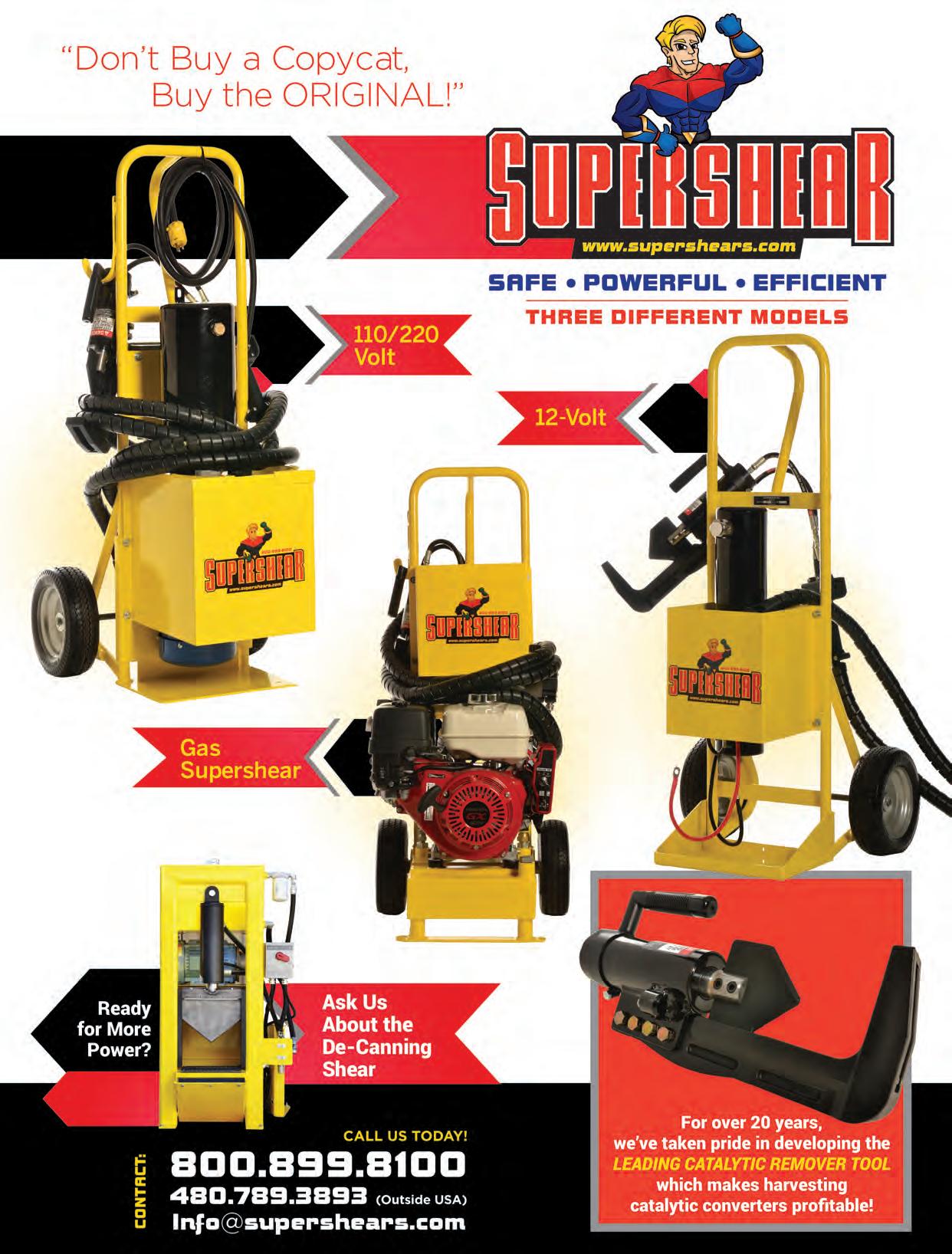
So, will this be a “golden age” for PGMs or not? I sense that there are more positives here than negatives from a demand perspective, but it’s the macro-economy that will ultimately determine prices –and the stronger dollar and higher-yield environment may continue to weigh on the precious metals complex.

Wilma Swarts, Director of PGM Research, Metals Focus
Although it’s still early days, the Republicans’ increased legislative influence could foster optimism around demand, particularly with the potential for extended internal combustion engine use at the expense of electric vehicle penetration. This shift may place upward pressure on platinum group metal prices. However, a potential rollback of commitments to tighter emissions standards, as seen previously with EPA regulations, could dampen PGM demand. Higher PGM prices, in turn, could stimulate increased scrap supply, as many of the recyclers you mentioned were waiting to see the election outcome.

Dr. Sandeep Kaler, Market Strategy Analyst, SFA (Oxford) Limited
It is tricky to predict the exact outcome for PGMs, but I think it is a slight positive compared to a Democratic win. We may see ‘stronger for longer’ PGM demand from the U.S.
Trump is notably less pro-EV than Harris, despite Elon Musk’s endorsement. However, I think it will be very difficult to completely reverse four years of EV support, especially since Republican states have been significant beneficiaries of the IRA and funding for EV and battery factories. What we will likely see is a slowdown in EV adoption if the $7,500 consumer credit and other benefits are revoked. Ultimately, this is
SO, WILL THIS BE A “GOLDEN AGE” FOR PGMS OR NOT? ... THERE ARE MORE POSITIVES HERE THAN NEGATIVES FROM A DEMAND PERSPECTIVE.
Oil is also lower, as Trump is perceived as wanting to increase production. It’s interesting that PGMs are down, likely due to speculative moves based on gold and silver declines. Cheaper fuel should benefit the ICE, but it’s still early days. The “buy the rumor, sell the fact” trade is currently in play. Remember, this is why you hedge.
good for ICE and the ‘legacy’ automakers – GM, Stellantis, and Ford who have built their core businesses on ICE and have recently been pressured to switch their portfolios to include more EVs.
For the automotive catalyst recycling market, numerous factors come into play. Support for the auto industry could drive up vehicle sales and be positive for recycling. However, any supply chain disruptions resulting from tariffs and trade negotiations could counteract this. Trump has also been noted for his inflationary policies – the impact of higher interest rates on auto loans could lead people to hold onto their vehicles for longer or opt for a secondhand purchase, potentially suppressing recycling volumes for longer.
Palladium prices have seen a very sharp decline over the past few days; this is the correction I predicted. The talk of sanctions was relatively shortlived, and the rally was an overreaction from the market.

And here we go; we’ve got our result. Pollsters weren’t even close again. Now you have some certainty? Maybe.
Equities are surging alongside the dollar; yields are up, and gold and silver are taking a hit, while crypto is also moving to all-time highs.
Trump’s focus on U.S. drilling and tariffs on foreign vehicles should be good for PGMs in the medium to long term. Once we get past today’s knee-jerk selling, we should start building a stronger base on ICE demand. For what it’s worth, the flip side is that the G7 likely won’t impose any embargoes on Russian PGMs. However, the first point should take precedence, as PGM prices were stronger the last time we had access to Russian PGMs.
Most economists believe Trump’s tariff plan will significantly increase inflation; one school of thought is that central banks may stock up on gold as a hedge against the dollar. Time will tell.
Historically, PGM prices are relatively moderate compared to their peaks over the past two decades. Between 2014 and 2024, platinum prices decreased by approximately 29%, while palladium rose by about 25%, and rhodium saw a significant increase of around 298%.
Commodity sales are an important source of cash flow for businesses in today’s economy. Take advantage of dollar-cost averaging by selling continuously into the market year over year. But if you have an appetite for speculation, treat your PGMs like any other investment by putting them into a tradeable form (troy ounces) with a reputable company in a pool account that can be valued as an asset until a future sale.
For daily updates on the PGM markets, subscribe to the United Catalyst Corporation daily e-newsletter, the 60-Second Report; visit bit.ly/4fr92Qs). To learn more about recycling converters on assay or the United Ecosystem Bid Tool, you can also call an account executive at 864824-2003 or email a specialist at sales@ unitedcatalystcorporation.com. TB


The integration of technology into the sales process has reshaped how businesses operate, making sales teams more efficient, data-driven, and customer-centric. Technology allows for deeper insights, faster responses, and more personalized approaches. In an increasingly competitive marketplace, staying ahead means leveraging the tools and platforms that optimize performance. From Customer Relationship Management (CRM) systems to artificial intelligence (AI), the modern sales landscape has been radically transformed.
Traditionally, sales were primarily about building relationships, persistence, and human interaction. Salespeople relied on phone calls, in-person meetings, and physical documentation to close deals. However, as businesses became more globalized and consumer expectations shifted, so did the methods of engagement. The rise of the internet and digital tools has revolutionized the sales environment, bringing efficiency, scalability, and better data to the forefront.
Early sales tools were limited to basic customer databases and spreadsheets, but as technology advanced, so did the possibilities. Now, modern sales professionals use powerful systems that automate much of the process, offering real-time insights into customer behavior and preferences. This evolution has not only made sales processes more efficient
but also given sales teams access to more detailed information, enabling them to build stronger relationships with clients.
At the heart of most modern sales strategies is the Customer Relationship Management (CRM) system. A CRM is a centralized platform that tracks all interactions a business has with its customers. This includes communications, purchase histories, preferences, and any ongoing negotiations. By consolidating this information, CRMs allow sales teams to have a complete view of each customer, making it easier to tailor their sales strategies.
Popular CRMs like Salesforce, HubSpot, and Zoho provide features like lead tracking, opportunity management, and pipeline visualization. The key advantage of these tools is that they centralize data, making it easily accessible and shareable across departments, allowing for seamless collaboration. Furthermore, CRMs can integrate with other systems like email marketing platforms, social media, and analytics tools to give a more holistic picture of customer engagement.
The automation capabilities of CRM systems are also invaluable. Salespeople can automate routine tasks such as follow-up emails, data entry, and

report generation. This not only saves time but also ensures that no customer interaction falls through the cracks. By automating these mundane tasks, sales teams can focus more on relationship-building and closing deals.
The amount of data available to modern businesses is staggering, and for sales teams, harnessing this data can be the key to success. Data analytics allows sales professionals to track trends, forecast demand, and understand customer behavior on a deeper level. This is where the fusion of sales and technology shines—using data to make informed decisions rather than relying on intuition alone.
With tools like Google Analytics, Tableau, and Power BI, sales teams can gather insights about customer preferences, website behavior, and purchasing patterns. This data can then be used to predict future sales trends and to identify which products or services are most likely to sell. Additionally, businesses can use analytics to assess their sales performance in real time, enabling them to make adjustments to their strategies quickly.
One significant aspect of data analytics in sales is the ability to segment customers based on behavior, preferences, and demographics. This segmentation allows for more targeted marketing and sales approaches, ensuring that sales teams focus their efforts on the most valuable leads.
Artificial Intelligence (AI) is perhaps the most revolutionary technology impacting sales today. AI is
With 30 years in automotive recycling, Rob Rainwater is a Strategic Business Consultant with the Profit Team Consulting. His talent lies in transforming industry businesses into multi-million-dollar companies. His focus is in the development of strong leaders, teams, and automatic profit centers. Reach Rob at 518-257-0663 or email rainwaterrobert@gmail.com
transforming the way businesses approach sales by automating complex processes, enhancing customer interactions, and providing predictive insights. Through AI-driven chatbots, automated emails, and smart CRM integrations, companies can maintain consistent and personalized communication with leads and customers.
AI can analyze vast amounts of data much faster than any human could. For instance, AI algorithms can predict which leads are most likely to convert into customers, allowing sales teams to prioritize their efforts effectively. AI tools such as Salesforce’s Einstein, Microsoft’s AI solutions, and IBM Watson can enhance the capabilities of CRMs by offering real-time insights, such as which customers are ready for a follow-up or which ones might be considering churn.
Chatbots powered by AI are another example of how automation can streamline the sales process. These bots can handle simple customer queries, qualify leads, and even schedule appointments, all without the need for human intervention. By handling these preliminary interactions, chatbots free up sales teams to focus on higherlevel tasks such as negotiations and closing deals.
Social media platforms have become integral to the sales process, especially in today’s digital age where customers spend a significant amount of time online. Social selling is the practice of using social networks like LinkedIn, Facebook, Instagram, and Twitter to find, connect, and nurture prospects. This approach allows sales teams to meet customers where they are and build relationships in a more organic way.
With the help of technology, salespeople can monitor social media channels for potential leads and customer conversations, using tools like LinkedIn Sales Navigator or Hootsuite. Social listening tools also allow companies to track brand mentions, customer feedback, and competitor activity, helping sales teams to engage at the right moment with the right message.
Moreover, social selling builds trust with potential customers by engaging them in a less formal setting. Instead of cold calls or unsolicited emails, social media allows for a more conversational and educational approach. It is about providing value to customers first, which helps foster relationships and drives sales in the long term.
Sales professionals are no longer confined to their desks. With the rise of smartphones and mobile apps, sales teams can work from virtually anywhere. Mobile sales tools allow sales reps to access CRM data, communicate with prospects, and manage their pipeline while on the go. This level of flexibility is crucial in today’s fast-paced business world, where responsiveness can make or break a deal.
Apps like Salesforce Mobile, Zoho CRM, and Microsoft Dynamics 365 enable sales professionals to access customer

data, view analytics, and collaborate with their team in real time. Additionally, mobile email clients, video conferencing tools like Zoom or Microsoft Teams, and messaging platforms like Slack make it easier to stay connected with clients and colleagues, even when out of the office.
Mobile tools have also enabled the rise of virtual selling. Salespeople can conduct virtual product demonstrations, host webinars, and close deals over video calls. This flexibility has become especially valuable in a post-pandemic world, where in-person meetings are not always feasible.
Sales enablement platforms, such as Seismic or Highspot, provide the tools and content sales teams need to engage prospects effectively. These platforms offer resources like training materials,
product information, and customer case studies, all of which help salespeople to better understand and communicate with their prospects.
Sales enablement tools also streamline communication between sales and marketing teams. By aligning these two departments, businesses can ensure that their messaging is consistent and that sales teams have access to the latest marketing assets.
While technology has undoubtedly transformed the sales landscape, it is not without its challenges. One of the primary concerns is the risk of overautomation. When too much of the sales process is automated, it can lead to impersonal interactions that lack the human touch necessary to build strong relationships. It’s essential for sales teams to strike a balance between automation and personal connection.
Another challenge is the complexity of technology adoption. With so many tools available, businesses may struggle to choose the right ones or fully integrate them into their workflow. Proper training and ongoing support are critical to ensuring that sales teams can leverage technology to its full potential.
Technology has undeniably transformed the sales profession. From CRM systems that track every customer interaction to AI tools that predict customer behavior, the integration of technology has made sales processes more efficient and effective. However, the most successful salespeople will always be those who understand that technology is a tool to enhance, not replace, human connection. By leveraging these tools in thoughtful and strategic ways, sales teams can thrive in today’s fast-paced, data-driven business world. TB

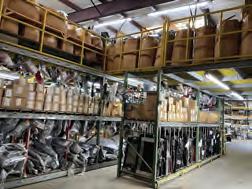
Were you at the ARA’s 81st Annual Convention & Expo?
I sure hope you were, because you know that I think tradeshows and conventions are the BEST way to be a better businessperson! You get to talk to tons of other people in your industry, learn from people who have already solved the problems you’re dealing with, and teach people who can learn from you.
You also get to hear from the vendors and businesses who provide you with your software and services. That’s what I want to talk about today. If you came to JC Chastain’s Tech Talk, if you attended the Carbon Credits panel that Joanna Cohen participated in, or if you stopped at the Car-Part.com/Checkmate booth during the show, you probably heard a lot about CO2e ! CO2e is “carbon dioxide equivalent,” and its very valuable data that Car-Part.com is using to promote your recycled parts to the buyers who value CO2e info. I bet you even got one of our cool shirts!
Car-Part.com now shows CO2e savings on popular recycled parts, making it clear that choosing recycled parts helps the environment. The CO2e data in search results shows the greenhouse gas emissions saved by choosing recycled parts over new ones. For parts that we have data for, each recycled part in the search results gets a note on it about the CO2e savings, and the whole screen has a green banner on top promoting the CO2e savings of choosing recycled parts. Checkmate is also going to release a feature next year that will let you put this info on your statements, quotes, and invoices for your customers.
Personally, I don’t think that our industry does enough to let people know that recyclers were “green” before most other industries, and this will help us
toot our own horn, so to speak. I can’t wait to see the results of our hard work printed on all of my invoices!
The collision repair and insurance industries are focusing on net-zero goals for their supply chains and the shops they work with. Carbon savings are now being considered right alongside cost savings when repairers are shopping for auto parts. Because choosing recycled parts significantly reduces emissions, this is a great marketing opportunity for recyclers!
I always say, ‘we were green before it was cool’! It’s true! You and I know that recycled parts are not only affordable and readily available, but also GREEN! But now we have a way to actually show that to buyers as they’re shopping. For example, if you look up an engine on Car-Part.com, you’ll see that the recycled engines save about 1194 kg of CO2e. That’s equivalent to the emissions from driving diagonally across the USA, from San Diego to Boston, and I think that’s pretty incredible!
The CO2e savings data that CarPart.com is using now is primarily based on a recent Ontario Automotive Recyclers Association (OARA) environmental impact study. The study calculates the potential emissions avoided when a recycled part is used instead of a new one.
Just a reminder that this CO2e data is currently based on part code. But we’re

working to improve the data in the CO2e Savings Reports to include more parts and include distinctions for various popular vehicle types. Car-Part is grateful to OARA, ARA (coming soon), and other Car-Part industry partners for providing the data used in CO2e calculations!
As always, have a great month and call, text or email me with any questions or comments at TheresaC@car-part.com or 859-802-2382. TB

Theresa Colbert is a Sales and Training Specialist at Car-Part.com. Her goal is to find the correct product to fit each customer and make sure that they are trained to use it. Reach Theresa at 859-802-2382 or email TheresaC@Car-Part.com.
Do you want to sell more auto parts? Of course you do; who doesn’t? What if I told you that you can accomplish this quickly and effortlessly, simply by making a choice? But here’s the rub: Some reading this may feel it is a way of selling out.
Selling aftermarket parts to your customers.
We pride ourselves on selling ROE–Recycled Original Equipment® (ROE®) auto parts. Given the choice, we will choose time and time again to sell our own product first and foremost before we sell anything else. When a customer needs a part we don’t have in stock, many of us will buy it from another auto recycler. There is no shame in brokering a sale, satisfying a need, and capitalizing on profit potential. While our competition may financially benefit from this, if we are buying and selling according to where our individual numbers should be, then we are strengthening our own business. Through this commerce, we are growing the industry and our relationships with customers and vendors. What happens if someone asks us to find aftermarket parts? Does the same concept apply here, or do we believe that we are giving in to competition and potentially weakening the recycled parts value chain? Does the continuing stigma surrounding aftermarket parts keep auto recyclers away from tapping into its unique opportunity? Are we willing to reexamine current demand and market shifts in order to embrace the aftermarket parts platform as the new trend and revenue stream, or is it truly not worth engaging with the enemy for your bottom line?
Now, to be honest, if I were to propose

Brian
this to myself five years ago, I would have been like, “You’ve got to be kidding me ... [insert an expletive or two].” There was no way I and many others would entertain this notion back then. My seasoned sales experience, coupled with my ignorant, albeit ill-informed, perception of the aftermarket parts market, would have been screaming, “There is no way we are going to peddle that cheap junk.”
are still replacement parts for vehicles not made by the original equipment manufacturer (OEM). Different companies produce them with different resources and often use different processes than the OEM parts they will replace. What has changed? Why should we reconsider aftermarket parts as part of our paradigm shift? Well, let’s look at what aftermarket parts are and the pros and cons of these products.
We get the advantage by adapting to the needs of the customer and accommodating them with options. We must create our own opportunity, maintain control of the sale, and keep the competitive edge.
The biggest pro for aftermarket parts has been and still is the cost savings element. They allow for affordable repairs and usually are sold at a fraction of the cost of a NOS or OEM part. Aftermarket parts suppliers produce more than just a few of each part, so the availability of quantity in stock is also a major benefit. Another major pro is that these replacement parts are new and have the ability to optimize, upgrade, and enhance the quality of the repair and the entire job. This gives aftermarket replacement parts advantages compared to the ROE auto parts or parts sourced directly from a manufacturer or the OEM dealers.
It is a product that is made overseas, takes forever to arrive, often doesn’t fit right or is poorly designed, and will be a hassle if we want to return it.” This may sound familiar to you, and I dare say that many recyclers and even consumers still hold this common opinion.
Up until the last five years, there was truth in the experience that customers had with buying aftermarket parts. They
Often aftermarket parts come bolt-on ready. They generally cost less in labor and materials to the overall scope of the job, whereas ROE parts may have damages, blemishes, or other variables that must be addressed. These factors alone create significant competition between the aftermarket and ROE auto part suppliers, causing the ROE parts sector to showcase their advantages while trying to chip away at the pros of aftermarket parts outfits.
Where aftermarket parts offer these benefits, they have also seen their fair share of cons that have left customers
and auto recyclers skeptical about these replacement parts.
We have all encountered situations where certain aftermarket parts lack the necessary data or interchangeabil ity to match the exact fit of OEM parts. This lack of data has led to design errors causing parts to not fit or function properly. Lower overhead during the production of these replacement parts allows them to be sold at a fraction of the cost of a new one from the dealer. Yet the trade-off translates into the quality, functionality, durability, and longevity of the state of the replacement part. Enter the perception of the word cheap here. Lack of proper resources or alternative designs has led to producing parts that are not the correct fit. Some parts designs have led to unforeseen needs for modification in order to make some of these so-called bolt-on-ready replacement parts fit the job.

the cost and the delivery time that have put aftermarket parts in direct competition with our ROE auto parts.
Let’s review what makes a customer choose aftermarket parts versus ROE auto parts.
among employees jockeying for promotion and competition between businesses to earn more customers or take business from competitors. We face strife within our industry via manufacturers versus subsidiaries, price wars, and supply control to hedge the market share. How we compete with these forces is a major part of each of our operations’ success.
Customers have also experienced these replacement parts failing over a short period of time or not holding up to certain elements and variables. As examples, we have witnessed an aftermarket catalytic converter that proves only to be good for about a year, or an aftermarket headlight that takes on moisture within the first three months of being installed. Other significant cons are the time you had to wait for this potentially problematic part to arrive and the warranty and return policy hassles, or a lack thereof of them.
Today, the aftermarket sector has adapted to the demand of the customer and is keeping pace with today’s insatiable need for instant satisfaction. They have begun to overcome their shortfalls. The design and quality for a lot of these replacement parts have improved over time. Customization, variety, and availability have become staples for these products, allowing more customers to get more of what they are looking for. They have even shifted in the direction of greener practices and are moving in step with the era of decarbonization. But if we are to talk about brass tactics, it is
By not shipping and delivering our parts to customers in the timeframe they are expecting, we are missing an opportunity that the aftermarket parts suppliers are capitalizing on. Therefore, the customer has the option to either wait days for a ROE part or have a new one delivered to their door the next day via prime shipping. Well, even to us that’s a no-brainer.
We also need to analyze the price margin. Our ROE parts, in some cases, may fit better but cost more than the aftermarket choice. In some cases, our parts are priced significantly more due to the availability of year, make, and model options, or even the part type. Another challenge to consider is the limited access to a reputable or reliable quantity of inventory available for the parts due to the cost of end-of-life vehicles at the auctions. Then, factor in the cost of labor involved in dismantling certain parts, it adds up.
So how is the recycler to compete? We get the advantage by adapting to the needs of the customer and accommodating them with options, such as the products of our competition. We must create our own opportunity, maintain control of the sale, and keep the competitive edge. We already face with rivalry
Did we get into business thinking we would compete with different countries over end-of-life vehicles at insurance auctions each week? Absolutely not. Did we come into the game thinking we would yield higher revenues by winning the race to the bottom? Don’t think so. Did we ever imagine ourselves living in the era of Amazon, where aftermarket parts sell at a fraction of the price of our ROE parts? I think not!
In conclusion, from this auto recycler’s humble opinion, control what you can control and do your research before you decide how to address these replacement parts. They can be a complement to the bread and butter of our ROE parts when done right. Your business can tap into the profit potential of selling these replacement parts, but more importantly, you will be satisfying your customers and potentially yielding new ones by offering this service.
Capitalize on this opportunity by choosing which replacement parts to buy and sell that fit your customers needs and suit your company’s interests. By incorporating aftermarket parts into your business model, you control the narrative. You will be continuing to strengthen the reputation of the auto recycler as a reliable and leading source in the industry while gaining a competitive advantage through your versatile parts accessibility and availability. Be an agent of change while maintaining caution.
Continue to move forward and increase parts sales through innovative strategies and by remaining ahead of the curve and the competition. TB
In October 2024, palladium prices spiked nearly 9% in a single day, reaching levels unseen for almost a year. This sudden surge has drawn attention from investors, analysts, and particularly automotive recyclers, who closely examine the factors driving this spike and how it affects their operations. Here, we’ll explore the critical elements shaping the palladium market, from supply-chain disruptions to economic and geopolitical forces, and what they mean for automotive recycling.
A major driver behind the recent price surge is escalating geopolitical tension. The United States recently urged the Group of Seven (G7) countries to consider sanctions on Russian palladium exports, which could disrupt global supply. Given Russia’s position as one of the largest palladium producers, sanctions would restrict availability, driving up prices.

Palladium is a rare and valuable metal essential in automotive catalytic converters, which reduce harmful emissions in gasoline-powered vehicles. While other metals, like platinum, are also used for emissions control, palladium’s unique properties make it the preferred choice in markets with stringent environmental regulations. However, the palladium supply chain relies heavily on Russia, which produces about 40% of the world’s output. This concentration of supply means that any geopolitical instability involving Russia can have significant consequences for the global palladium market.
For automotive recyclers aiming to maximize profits from catalytic converter recycling, this presents both challenges and opportunities.
While rising palladium prices can boost the value of recycled converters, increased competition for supply may also lead to higher acquisition costs.
Economic uncertainty is also fueling demand for palladium as a safe-haven asset. While investors traditionally turn to gold and silver, palladium’s limited supply and industrial significance make it particularly attractive. For recyclers, this means catalytic converters containing palladium are becoming more valuable, adding a profitable angle to recycling operations as investors seek stability in precious metals markets.
The recent decision by Stillwater Mining, a key palladium producer in the United States, to shut down some of its mines is further impacting the palladium supply chain. With operations centered in Montana, Stillwater Mining has long been a critical domestic source of palladium. However, rising operational costs, regulatory challenges, and the difficulty of extracting palladium from remaining sites have led to scaledback mining efforts. For recyclers, this reduction in domestic production could mean increased reliance on international sources like Russia, intensifying the impact of any supply chain disruptions and sanctions. The shutdown at Stillwater emphasizes the need for recyclers to focus on efficient recovery and recycling to stabilize supply and capitalize on rising prices.
In the short term, palladium demand for catalytic converters remains high, which could be beneficial for recyclers as prices increase. Should sanctions and supply issues persist, recyclers may see additional opportunities to profit from increased palladium value. However, the market’s volatility suggests recyclers should remain flexible and vigilant, as prices can fluctuate sharply due to speculative trading and geopolitical shifts.
Over the long term, palladium’s outlook is more uncertain. With the
automotive industry gradually shifting toward electric vehicles (EVs), which do not require catalytic converters, demand for palladium may decline. This transition could impact the profitability of catalytic converter recycling unless new applications for palladium emerge. For recyclers, diversifying the types of metals recovered and optimizing operations to adapt to a changing market landscape will be essential as EV adoption grows.
Although palladium’s price surge is grabbing attention, other metals like platinum and rhodium remain vital to the recycling industry. Found in catalytic converters, these metals could see similar price trends in response to economic and political shifts. Monitoring these metals alongside palladium can help recyclers anticipate broader market trends and capture value across a range of precious metals.
A major driver behind the recent price surge is escalating geopolitical tension. ... This presents both challenges and opportunities.
The recent surge in palladium prices underscores the sensitivity of this market to global events, a critical factor for automotive recyclers. With potential sanctions on Russian palladium exports looming, demand for the metal in catalytic converters is pushing prices to new highs. While recyclers can benefit in the short term, staying informed and agile is essential as both the palladium market and the broader automotive industry shift toward sustainability.
As key players in the palladium market, automotive recyclers stand to gain by understanding these dynamics, positioning themselves to capitalize on opportunities while staying resilient against industry changes. TB

As Vice President of Business Operations at noble6, Garrett Schwenk brings a deep commitment and hands-on experience, working closely with both the operations and marketing departments to ensure strategic alignment and seamless execution of our recycling programs. noble6 specializes in the recycling of automotive components, including catalytic converters, oxygen sensors, spark plugs, and diesel catalysts. They are committed to transparency, trust, and fair dealing, aiming to build long-term relationships with our partners.

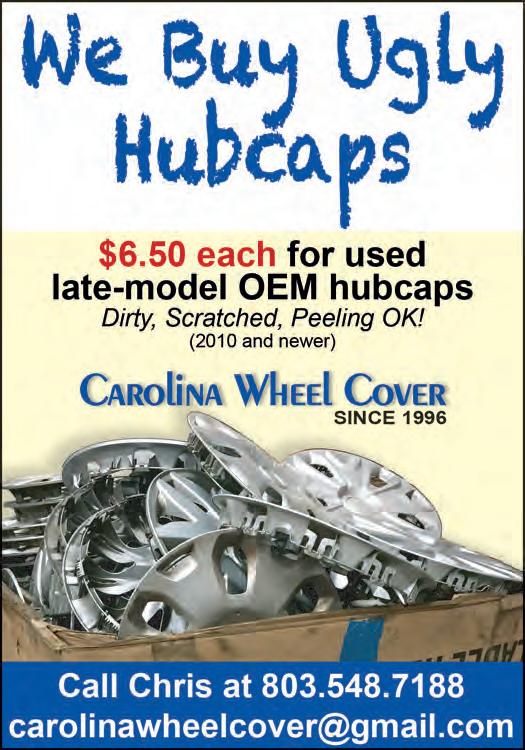
We have many clients who do not ship LTL freight frequently enough to master it.
Brokers, carriers, and 3PLs can be a good resource to help you. If you decide to do it yourself, and even if you are using one of these businesses, it is important in LTL shipping that you understand (at least on a high level) how transit times, pick-ups, and deliveries work for carriers.
Often, we have clients that call us and who are extremely annoyed due to a missed pick-up, lengthy transit time, and, of course, the dreaded late delivery. You can’t know everything, but understanding “time” in terms of how a carrier sees it is important to your mental well-being and setting expectations for your customer when you make the sale for a part that will be shipped LTL.
• TRANSIT TIME (TT): TT refers to the days your shipment is in transit. Pick-up and delivery days do not count. So always add two days to the TT (one for pick-up and one for delivery) to get your shipment from point A to point B. It is important to note that TT is ESTIMATED, it is not guaranteed. The best practice is to always communicate this to your customer. With LTL, there are guaranteed options, but the cost for these shipments is significantly higher than a normal LTL shipment. If a carrier misses a guaranteed shipment, the best they will do is remove the guaranteed charges and charge you for a standard shipment.
COMMENTS: TT’s are only as good as the carrier. There are some carriers that stick very close to their advertised TT’s and there are those that are nowhere close to their advertised TT’s. We’ve had shipments that were advertised as two days TT that took three weeks to arrive at their destination. While this is not ideal, staying in touch with the carrier for your shipment can help, and keeping your customer apprised will help keep the pressure at bay.
• PICK-UP DATE/TIME (PU): For every LTL shipment you book, you will provide a PU date and time. PU’s only occur Monday through Friday. Standard PU windows are 2-3 hours. PU dates and times are not guaranteed. If a carrier is a no-show for your PU on the assigned day and time, you will need to call the carrier to make sure they have
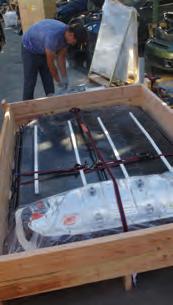
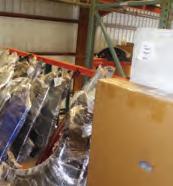
“rolled” over your shipment to the next available time and get a new “PU Confirmation Number.”
COMMENTS: While PU’s should happen on the date and time the PU was confirmed, there are a lot of things that can happen: truck got full, route not run on this day, driver got sick, truck had a flat, equipment broke down, train blocked the way, forgot to send truck with liftgate, and many other reasons. Whatever the cause, this is how LTL works.
• DELIVERY DATE/TIME: Just like pick-ups, unless you have a guaranteed delivery date and time, your freight will be scheduled for delivery when it makes the most sense for a carrier to deliver your freight. If there are added services, which you pay more for, like “liftgate delivery,” “residential delivery,” “inside delivery,” and more, it may take longer for the carrier to arrange delivery of your freight.
COMMENTS: Go back to see PU date and time comments. Any questions?
• REBILLS: What is a rebill? Anytime you are charged more than you were quoted, this is what is called a rebill. A rebill usually occurs due to an additional service that was provided by the carrier that goes beyond the standard pick-up and delivery of freight that occurred sometime between pick-up and delivery.
COMMENTS: Rebills occur on about 40-50% of all LTL shipments. As the shipper, you can control most issues that cause rebills to avoid them. If your BOL has the correct weight, dimensions, NMFC#, class, PU address, delivery address, 3rd party bill to info, added details to the BOL itself (deliver in back, no liftgate needed, additional consignee contact names and phone numbers, etc.) and all the services (accessorials) required at pick-up, when traveling, and finally for delivery – you will drastically lower chances of getting a rebill. A good percentage of rebills do occur where the carrier makes an error and charges you for an additional service or reweigh or re-dimension that you believe to be in error. All carriers have a process for disputing charges a shipper believes are incorrect. But, be prepared to pay the bill and work with the carrier on getting these charges refunded to you. You will have to pay the carriers per their terms, if you don’t, they will not ship for you until the shipment has been reconciled on their books.
In the future, I’ll dive into tariffs and accessorials. What’s a tariff? What’s an accessorial? I’ll let you know, and we will dive into the accessorials that could occur on your LTL shipment that you should be aware of that could make your freight cost more and ways to give your customers options that will keep your LTL shipping costs down. TB

Tony Jenkins grew up in the salvage business (Birmingham Auto Parks, Birmingham, MO) and his family still owns a salvage yard in Kansas City.
After spending 25 years in corporate America, in 2020 Jenkins started InXpress 308. Today, the majority of the business for InXpress 308 is with salvage dealers and other related industries. InXpress 308 is the only place where you can ship blinker fluid, flux capacitors, and muffler bearings for free. To learn more about Jenkins and his background, visit https://www.linkedin.com/in/asjenkins.
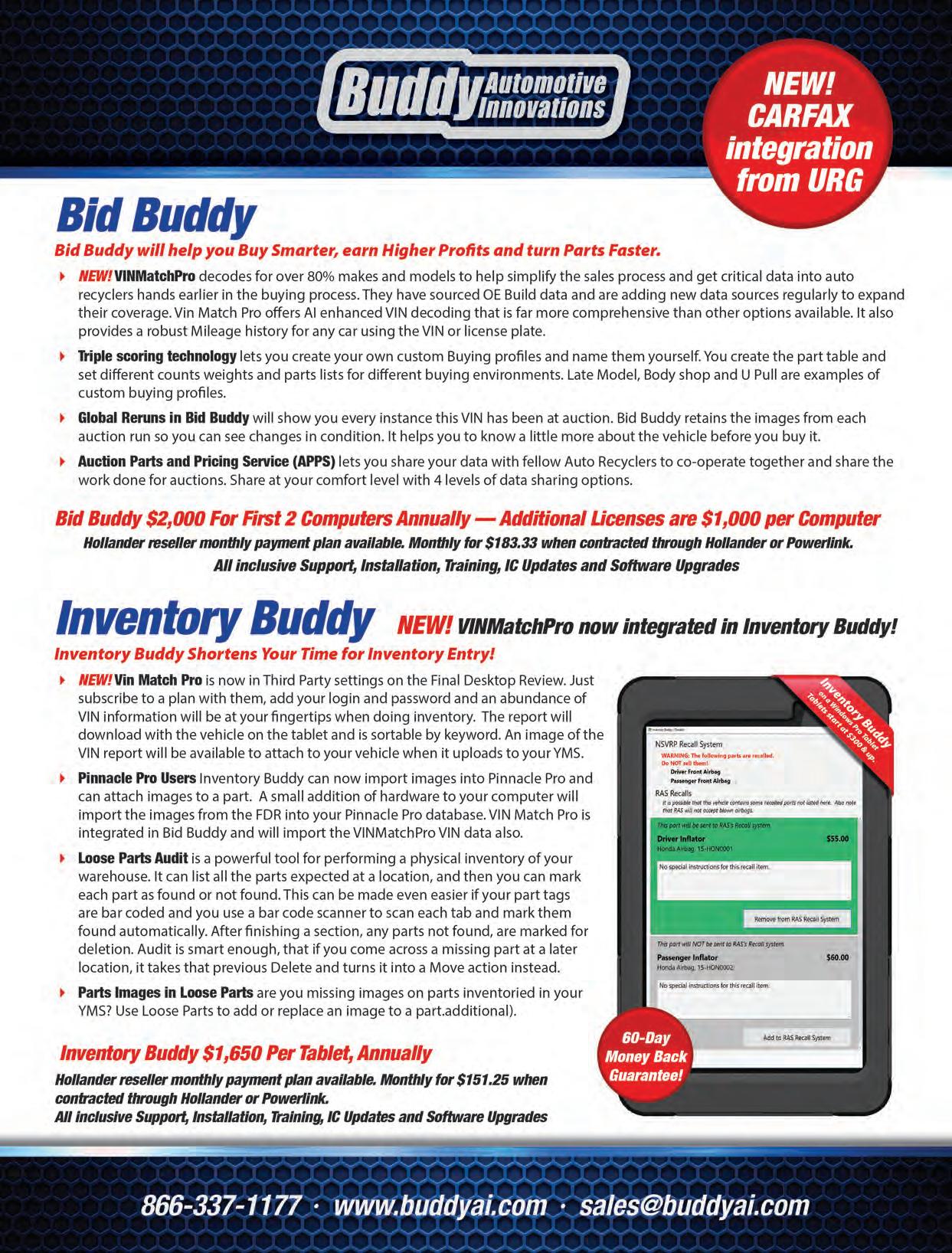
Many auto recyclers know Chris DiMarzio from Linder’s Inc.
What we didn’t know is that Chris is also an author of a great book, The Tides. I could not put it down and had to finish reading it before other stuff was completed on my agenda. You and I might know Chris as a great manager. We’ve heard him on the URG, “On-the-Go” podcast. People loved that session because Chris shared valuable tips on managing people.
Linder’s Inc., located in Worcester, Massachusetts, is a fine automotive recycling facility with the clever tagline “The Intelligent Automotive
Alternative.” Chris and his wife Lisa are residents of Ware, Massachusetts, and reside in the same home where they raised their three children, Denver, Julia and Sydney.
Chris enjoys painting and sculpting, but his life-long appreciation is architecture, art, theater, and music arenas, which led him to co-found Workshop13 Cultural Arts and Learning Center, a rural non-profit arts innovator devoted to increasing the appreciation and accessibility of the arts, strengthening the creative life of our

community through instruction, collaborations, and arts-based initiatives. It is there, within an old, renovated Queen Anne church, that artists gather to share their talents. And, it is there that Chris was inspired to try his hand at writing. The Tides is an enjoyable book.
Now that I know his talents, I have told a few friends that you know about Chris’ abilities, such as Paul D. Adamo and Bo Wroten. Both of them loved the book and wrote raving reviews about Chris’ book on Amazon.

Now, I am sharing it with you. This is how we, as an industry, can help one of our own. Buy the book and then write 3 or 4 lines on how you viewed the book. That’s it! The more we endorse Chris’ book, the more Amazon will help promote it as a number one book. As Chris so aptly wrote on the cover of his book, “The response to events in our life can forever change its course, and it all take place, between the tides.”
In this page turner, Chris created a character named Patrick Castingway, an American portrait artist who travels the country spending weeks at a time living with, and learning about, the people whose portrait he will be painting next. Hoping to better represent them on canvas, he focuses his attention not so much on the outward beauty of his


subjects, but the beauty within them. We all strive for harmony in our lives, but in life there is always conflict rising or receding, and with each new stop, he invariably gets pulled into theirs. And, it is at some of the lowest points in life that we reveal our truest selves. From one place to the next, he shares their joy and sorrow, their laughter and tears. Some visits more contentious than others, but in the end, in some small way, he helps them find resolution, which for years is something he’s searched for himself but
until now has been unable to find.
Everyone will enjoy this story, so let’s buy the book, The Tides by Christopher DiMarzio, one of our own, and celebrate his success with him.
If you need a gift idea for a special someone, or to get your copy of The Tides can be purchased at https:// www.amazon.com/Tides-ChristopherDimarzio/dp/1962987752. Today, the cost is only $17.99, and the book already has a 4.8 of 5-star review.
Chris is a wonderful person who deserves our support by helping to promote his fantastic book. When you receive your copy of The Tides, you’ll see why I’m asking for your support with his writing talent.
See you on the next podcast. Have a blessed New Year! In the meantime, keep writing, Chris! TB
D.J. Harrington is the President and Chief Executive Officer of Phone Logic, Inc., an international training company based in Atlanta, GA. He serves as a consultant and trainer to over 1,000 privately-owned businesses throughout the country, training personnel at all levels of the company, from the dispatcher to the customer service and sales staff. Please visit his website for more information at www.djsays.com.



Losing even one customer due to poor customer service can be far costlier than you might think. As business owners, we often focus on marketing and expansion, but neglecting customer relationships can undo all that hard work.
Years ago, I lost one of my most profitable clients over a petty disagreement. Frustrated and stressed, I spoke to them in a way I regretted almost immediately. I had been having a rough day, facing one crisis after another, and I let my emotions get the best of me. That momentary lapse in professionalism led to losing their business, which cost my company significantly.
After the call, I realized my mistake and tried to apologize. But by then, the damage was done. Reflecting on this incident, I know I should have taken a break before speaking to clients that day. Handling customers with respect and patience is crucial – especially in challenging situations.
The loss of a single, well-paying customer affects a business on multiple levels. First, there’s the immediate loss of their current purchase.
Beyond that, companies forfeit the lifetime value of that customer, which includes years of repeat business. For

example, if a customer spends $100 monthly and remains loyal for ten years, that’s a lifetime value of $12,000. If they refer just one new customer per year, the combined financial impact grows even larger.
At a conference about advertising methods, I heard marketing guru Dan Kennedy explain the important distinction between customers and customer service representatives. Simply put, he said customers are assets who bring money into your company. In contrast, customer service representatives, though essential for operations, take money out of your company and are considered expenses due to their salaries and benefits. He emphasized that business owners must recognize the differences between these groups to protect their company’s financial health.
This distinction is why customer satisfaction should be every company’s top priority. Creating and maintaining loyal, satisfied customers is the foundation of long-term success. Losing customers not only impacts immediate revenue but also reduces potential future business and referrals. Kennedy also pointed out that keeping a current customer is far more cost-effective than acquiring a new one. Therefore, businesses should strive to build long-term relationships with their customers to
ensure each one feels valued and wellserved. Training your customer service representatives to handle customers’ needs can make a significant difference in retention and overall satisfaction.
You’d think that after my initial experience, I would have mastered the art of calm communication with people, but even seasoned businesspeople can get frustrated. Last spring, I encountered a major problem with an expensive lap pool purchased from a local dealer. The pool wasn’t working properly, so I reached out to the dealer. However, instead of speaking to a human, I was forwarded to a recorded message that instructed me to explain my issue after hearing a beep.
Several days passed without any response. I tried many more times to reach them but only received the same recorded message. As days turned into weeks, my frustration grew. Finally, someone picked up – just the receptionist. When I expressed my frustration, she responded defensively, saying they were overwhelmed and that I would “just have to wait my turn.” She also mentioned that she had received seven calls that morning with complaints just like mine and wasn’t in the mood to hear more. I was surprised to hear her say that!
This response only intensified my frustration, so I suggested that hiring more staff might help them serve their
Mike French is retired after 39 years of business in the automotive recycling industry. He is an author, publisher, consultant, and speaker. Mike is the founder and executive director of the Christian Auto Recyclers and Vendors Association (CARVA) and will be at upcoming recycler trade shows and events. Mike is available to speak at your group, conference, or event. He loves to share inspirational stories that demonstrate how the Word of God actively changes lives. He can be reached at mike@carva.group. Visit www.CARVA.group and/or www.PowerPackedPromises.com.
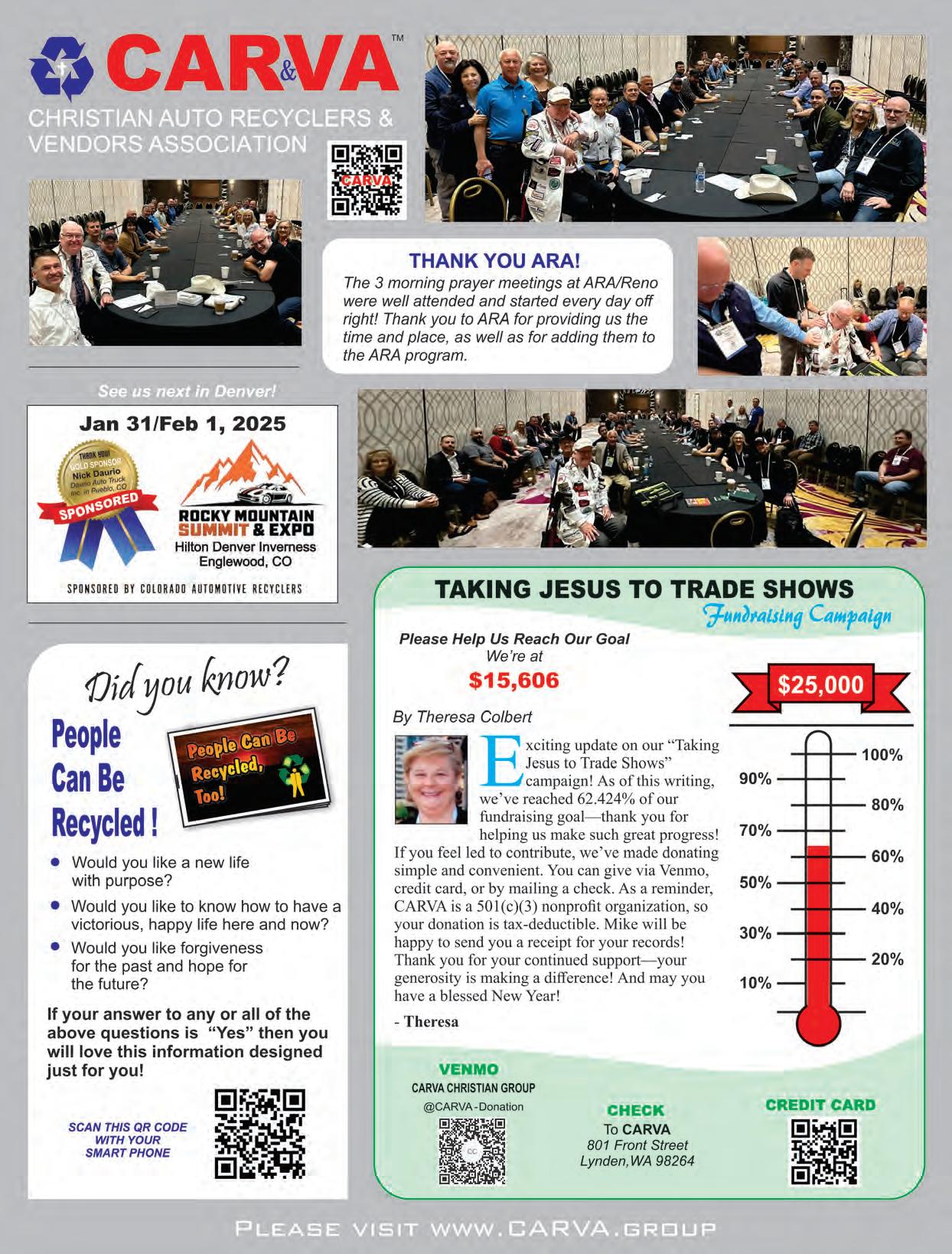
customers better. She took offense, snapped back, and hung up on me. I ended up having to contact the pool manufacturer to find another certified dealer willing to help, but that was both inconvenient and costly, as there were none nearby.
Looking back, I can see that I allowed my frustration to affect how I spoke to her. I should have paused, taken a breath, and handled the situation calmly. Losing my temper did not help resolve the problem; it only fueled the tension. Had the receptionist been trained in customer service and how to relate calmly to a disgruntled customer, she might have also responded differently. Instead, her reaction – shaped by her feelings rather than the needs of the customer and her company – compounded my frustration and left me with a negative impression of the business. As a result, I left unhappy and will bring no more money into their company.
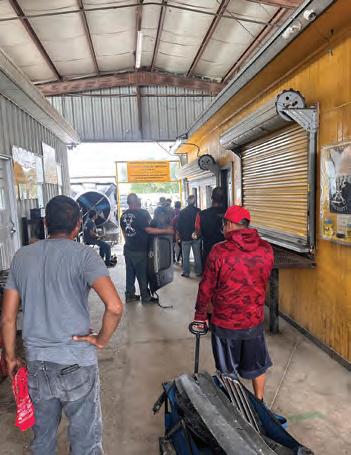
This incident reinforced Kennedy’s observation: I, as a customer, am a financial contributor to their business, while employees like the receptionist are financial expenses. If companies do not properly train customer service representatives, situations like these will keep occurring. A professional response from the representative could have changed everything. Training is key to helping customer service representatives handle challenging situations,
remain calm, and turn negative experiences into positive ones.
It used to be said that a dissatisfied customer shares their experience with 27 others, which was certainly true in the past. But in today’s digital world, it’s much worse! A single negative review on social media or review sites can reach hundreds or even thousands of people and do massive damage to a company’s reputation and income.
Therefore, every business must invest in customer service training. When companies equip their representatives to handle difficult situations, stay calm, and prioritize customer needs, they can achieve higher customer satisfaction, receive better reviews, and build stronger customer loyalty.
Also, ARA members get free training videos at ARA University, which include phone tips in the Sales module. Check out https://arauniversity.org/courses/.
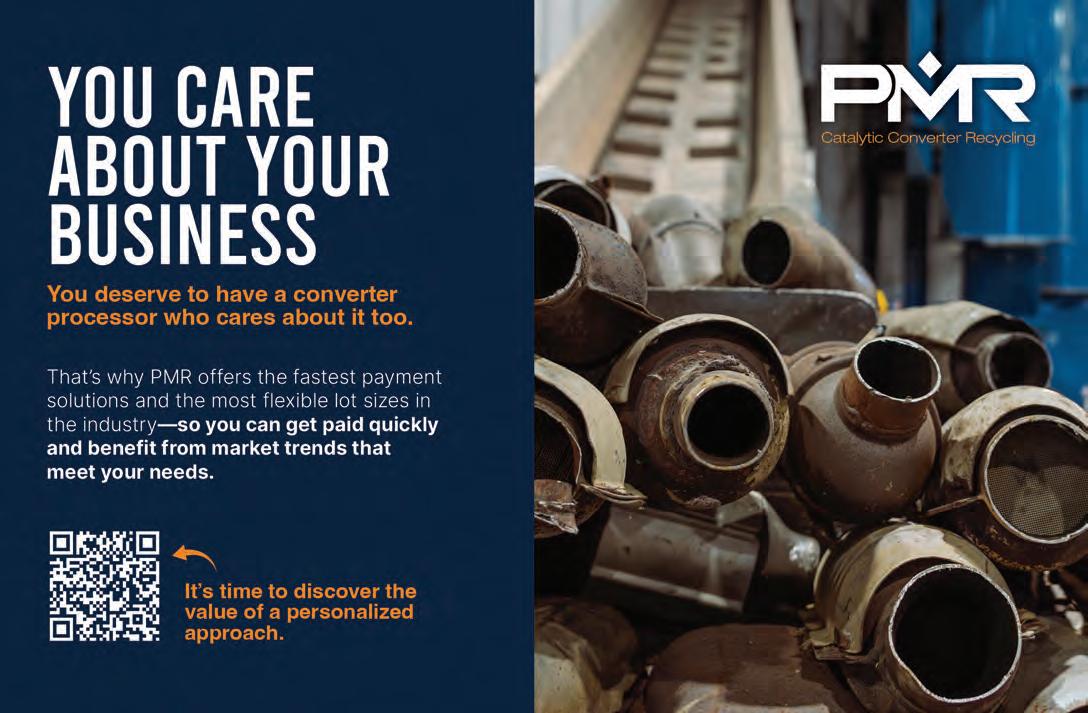
Here are some key strategies that can help improve your company’s customer service and create a positive experience for customers, even when issues arise:
1. HIRE POSITIVE REPRESENTATIVES: Friendly, outgoing individuals who genuinely enjoy helping others tend to be more effective in customer service roles. A positive attitude is contagious and can significantly improve interactions with customers.
2. INTRODUCE YOURSELF AND YOUR COMPANY: Start every conversation by introducing yourself and your company. For example, “Hello, this is Mike from JC’s All Models Parts Place. How may I assist you today?”
3. SMILE WHILE YOU SPEAK: A smile can be heard in your voice, even over the phone. Smiling while you talk projects warmth and friendliness, which can help calm and reassure frustrated customers.
4. USE THE CUSTOMER’S NAME: Ask for the customer’s name and use it
throughout the conversation. People appreciate being addressed by name; it creates a respectful personal connection.
5. CONTROL YOUR EMOTIONS: Avoid answering calls when you are frustrated or upset. Customers will sense your emotions, which can escalate tension if they are already unhappy.
6. MAINTAIN A CALM AND CLEAR TONE: When speaking with upset customers, a calm voice can help soothe them. Your tone often influences theirs.
7. BE COURTEOUS AND RESPECTFUL: Politeness goes a long way. Using “please” and “thank you” consistently helps foster goodwill.
8. SHOW EMPATHY: Acknowledge the customer’s feelings. Say something like, “I’m sorry this happened to you. I’ll do my best to help resolve it.”
9. LISTEN ACTIVELY: Give the customer your full attention. Don’t interrupt; allow them to fully explain their issue before responding.
10. INQUIRE ABOUT THEIR NEEDS: Ask customers what solutions they
envision to make them happy. This can help you address their expectations directly.
11. EXCEED EXPECTATIONS: Go above and beyond to resolve issues. When customers feel valued, they are more likely to stay loyal and spread positive word-of-mouth.
12. FOLLOW-UP: After resolving the issue, follow up to ensure everything is satisfactory. A quick message can reinforce that you care about their experience.
Quality customer service is not only a worthwhile investment; it’s essential for attracting, retaining, and delighting customers. Impressing customers with outstanding service during challenging times turns them into loyal advocates. Addressing issues with empathy and professionalism ensures that they continue to do business with you and recommend you to others. This builds customer loyalty, strengthens your bottom line, and enhances your company’s reputation. TB


Roberts Salvage roots go back just after World War II in 1946 when Arthur Roberts and two of his six sons bought a grocery and service station in Moffett, Oklahoma. They soon started doing mechanic work, parting out and scrapping cars. Soon, the other four brothers eventually came into the business. The company grew to include several auto parts stores in Fort Smith, Arkansas, and the surrounding area.
The company was eventually divided between the different family owners and in 1992 Roy Roberts and son Billy became the sole owners of Roberts Salvage. The business added property over the years and grew to encompass approximately 10 acres, and in 2013 the business added a 14-acre self-service facility about a half-mile from the main facility. My husband, Billy Roberts, is now the president of the business, and I serve as co-owner and corporate secretary.
I came into the business after working in the banking industry for 18 years. I handle all of the back office functions for both businesses, Roberts Salvage, Inc. and Roberts PartsU-Pick, which among other things includes accounts payables and receivables, title work, transport scheduling, payroll and vehicle sales.
I attended my first ARA (ADRA) conference in Kansas City in 1981 and most others since that time. All have been great for learning, networking, and fellowship. I have been able to travel all over the country and made a countless number of friends in the auto recycling industry from around the world and have enjoyed every minute.
—Janette Roberts
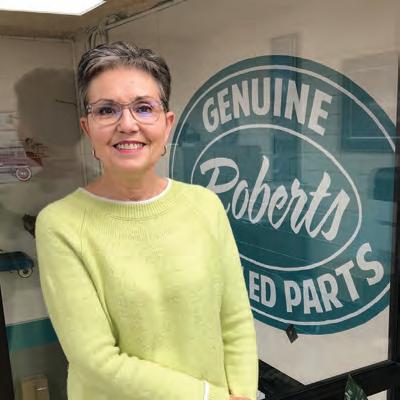
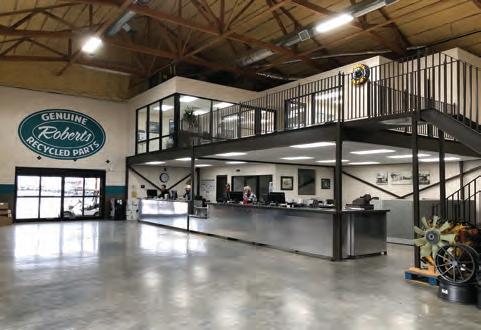

Why Gamble with Your Future was the theme of the Automotive Recyclers Association (ARA) 81st Annual Convention & Expo in Reno, Nevada, where the emphasis was to get beyond managerial, organizational, and procedural challenges sooner than later to prepare for a future that is fast-tracked. Building an infrastructure that prepares for fewer workers, advanced technologies, regulatory demands, insurance industry fluctuations, as well as new automotive business models, is key to an automotive recycler’s business sustainability.
The event reinvigorated the industry as approximately 500 auto recycler attendees, supported by 92 top-notch exhibiting companies, gathered to hear the latest on current marketplace opportunities and industry challenges to prepare for the future. ARA’s Committees boasted high attendance and participation, and reported much progress on marketing, governmental affairs, education and scholarship opportunities for the industry.
The Recycler Keynote set the tone in “Overcoming Complacency,” and was presented by Amber Kendrick, Owner, Pete’s Auto Parts. The key takeaway was to take care of yourself to be the best leader possible, challenge yourself and your team frequently, pay attention to the details of the business, and create systems that keep you on track.
Her compelling and relatable story recounted growing up in a family business, working for other recyclers to get experience, then returning as the owner of Pete’s, and a collection of hardships that ensued, including a devastating facility fire, insurance snafus, and getting sober in the process. The lessons have made her a better owner, she says, and she learned how not to let challenges send her to the sidelines.
“When you’re a business owner, in a family business, you encounter hard things. It’s not fun when you’re going through it. Eventually there were good blessings that came out of those terrible times, but not in the beginning.” Building on diligence grows your resilience.
Ryan Mandell, director of claims performance for Mitchell’s Auto Physical Damage division, focused on the impact of COVID-19 on vehicle values and insurance costs. By summer 2024, the U.S. will be 8.5% above normal vehicle values, returning to normal by 2026. Claims volumes are declining, with a 1% annual decrease attributed to economic factors. Auto insurance costs surged 43% in 2022, leading consumers to drop coverages or increase deductibles. This has reduced small claims, with fewer repairs, but increased consumer cost consciousness. Repair costs have risen 5.5% in 2023, driven by inflation and increased part usage. Despite fewer claims, the complexity of modern vehicles and higher repair costs persist.
Contrary to the belief that advanced safety systems are the primary cause for the decline, he notes the reason is more complex and can be traced to the steep rise in insurance premiums. Consumers are increasing their deductibles to lower their premiums, and therefore are self-paying for repairs. He believes that this presents an opportunity for auto recyclers.
“When people get their car fixed and the insurance company pays for it, they want all OEM parts. And then as soon as they’re paying for it, they want the cheapest parts possible. All concerns go out the window.” This he notes is an opportunity for ROE – Recycled Original Equipment™ parts providers.
• ARA Lifetime Achievement Award –Steve Fletcher, outgoing Executive Director of OARA – Ontario Automotive Recyclers Association
• ARA Lifetime Achievement Award –Fran Reitman, Reitman Auto Parts
• 2024 Presidential Award – Mike Lambert, Buddy Automotive Innovations LLC
• ARA STAR Member of the Year –Marty Hollingshead, Northlake Auto Recyclers Inc.
• ARA Certification Member of the Year –Bow Auto Parts

ERIC WILBERT, WILBERT’S U-PULL-IT, LLC, ROCHESTER, NEW YORK
Professional automotive recycler Eric Wilbert was recently welcomed as the new President of the Automotive Recyclers Association (ARA). Wilbert was formally confirmed as President on October 24, 2024, during the Association’s 81st Annual Convention and Exposition held in Reno, Nevada. He brings decades of experience in the industry and has served on ARA’s Executive Committee since 2021.
“The ARA has been advocating on behalf of the professional automotive recycler for over 80 years, it is my privilege to be a part of the Executive Committee and continue this legacy,” said Wilbert in his first remarks as Association President. “I am honored and humbled to serve our membership and the industry during my year as President.”
Wilbert is the Director of Self-Service Operations overseeing Wilbert’s three selfservice yards in Western New York. Wilbert’s is a family-owned operation, founded in 1952, with 230 employees. The operation also includes four full-service locations.

VINCE EDIVAN
NEW ARA EXECUTIVE DIRECTOR
The Automotive Recyclers Association is proud to announce that Vince Edivan has assumed the role of Executive Director for the Association, taking the helm at ARA’s recent 81st Annual Convention and Exposition in Reno, Nevada. “I am deeply honored to accept the role of Executive Director for ARA and want to acknowledge the remarkable contributions of Sandy Blalock and the dedicated leaders who preceded me,” said Edivan. “Their vision, hard work, and unwavering commitment have paved the way for ARA’s continuing success, and I am humbled to carry forward their legacy. I am excited about the opportunity to work collaboratively with industry stakeholders, while advocating for practices that promote the automotive recycling industry and serve the needs of our members.”
In December, Emil Nusbaum, ARA’s VP of Strategy, Government and Regulatory Affairs, traveled to Las Vegas for the 24th Annual Advanced Automotive Battery Conference. During the event, Emil gave a presentation on how policy and regulatory developments in state and federal governments are directly impacting how vehicle traction batteries are being handled at end-of-first-life and end-of-life. Emil also discussed pending legislative activity that may potentially impact the ability for automotive recyclers to acquire and safely process vehicles containing vehicle traction batteries. It is critical that automotive recyclers maintain the ability to ensure a steady stream of endof-first-life batteries that can be reused, repurposed and remanufactured. Without this ability and the information necessary to do so, it will be even more challenging for the U.S.

to recover the critical materials contained in vehicle traction batteries.
Following Emil’s presentation, he participated in a panel discussion with Shane Thompson of Cirba Solutions, Jessica Dunn from the Union of Concerned Scientists, and Renata Arsenault of Ford Motor Company. The panel was moderated by Steve Sloop of OnTo Technology, LLC and panelists discussed how policy makers can help industry create a robust and circular economy for vehicle traction batteries.
ARA’s Emil Nusbaum recently toured a WM recycling facility with members of the Commission to Advance Lithium-Ion Battery Safety in Maryland to learn more about the risks associated with improper disposal of lithium-ion batteries.
During the tour, which occurred at a materials recovery facility (MRF) for WM, commission members learned how recyclable goods are collected, sorted, and processed so that they can be used for the manufacture of new products. With the increase in products containing lithium-ion batteries, it has become critically important that these batteries are sent to the proper recycling outlets to prevent fire risks.
Findings from the facility tour will be incorporated into the work the Commission is doing to develop best practices and policy recommendations to the state of Maryland.


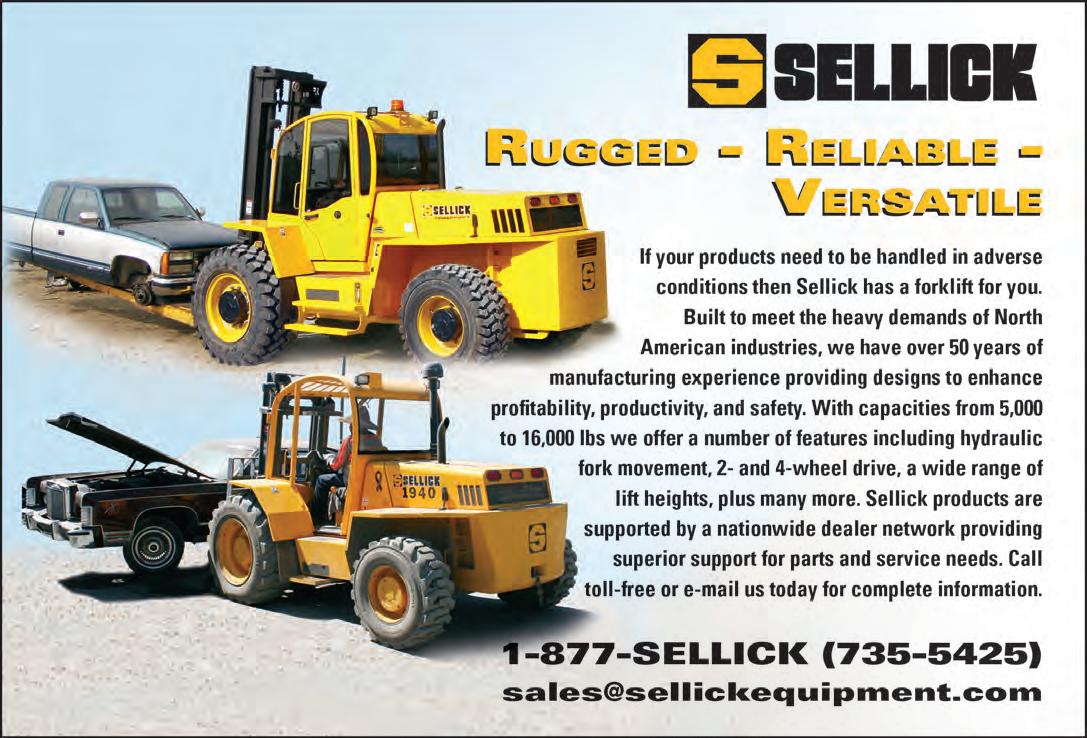

BY
IMPORTANT: RENEW YOUR SUBSCRIPTION AT https://autorecyclingnow.com/toolbox/subscribe THIS IS REQUIRED TO CONTINUE RECEIVING THE TOOLBOX!
The Automotive Recycling ToolBox™ Edition delivers peer-to-peer articles with information that you would get while networking at industry events and trade shows. Our mission is to be current, educational and inspirational. We bring you:
• Educational and instructional “how-to” articles written by fellow recyclers, top industry professionals, leaders & trade show speakers.
• Information from providers of industry-related products and service you typically find at industry events and trade shows.
PUBLISHED 6 TIMES A YEAR AutoRecyclingNow.com/Toolbox
AUTOMOTIVE RECYCLERS ASSOCIATION OFFICERS
TOOLBOX TEAM
Published by Driven By Design LLC
EDITOR
Caryn Smith, Toolbox@a-r-a.org
ART DIRECTOR
Caryn Smith
ADVERTISING SALES
Jay Mason, ToolboxAds@a-r-a.org
EXECUTIVE DIRECTOR
Vince Edivan
Automotive Recyclers Association
Vince@a-r-a.org
SENIOR DIRECTOR OF ASSOCIATE OPERATIONS
Jessica Andrews, Jessica@a-r-a.org
SENIOR DIRECTOR OF MEMBER SERVICES
Kelly Badillo, Kelly@a-r-a.org
VICE PRESIDENT OF STRATEGY AND GOVERNMENT AND REGULATORY AFFAIRS
Emil Nusbaum, Emil@a-r-a.org
CERTIFICATION CONSULTANT
Sue Schauls, Sue@a-r-a.org (319) 290-7843
PRESIDENT Eric Wilbert Wilbert’s U-Pull-It, LLC Williamson, NY eric.wilbert@wilberts.com
1ST VICE PRESIDENT Shannon Nordstrom Nordstrom’s Automotive, Inc. Garretson, SD shannon@nordstromsauto.com
2ND VICE PRESIDENT/TREASURER Sean Krause Speedway Auto Parts, Ltd. Joliet, IL sean.krause@speedwayap.com
SECRETARY Tom Andrade Everett’s Auto Parts Brockton, MA tandrade@everettsautoparts.com
IMMEDIATE PAST PRESIDENT Nick Daurio Daurio Auto Truck Pueblo, CO nick@daurioauto.com
ARA CONTACT INFORMATION
ARA Headquarters Manassas, VA (571) 208-0428 staff@a-r-a.org www.a-r-a.org
To reach readers with print & digital advertising, email ToolboxAds@a-r-a.org
For editorial contributions, e-mail Toolbox@a-r-a.org or call (239) 225-6137.

